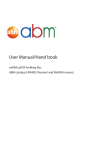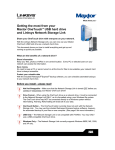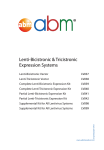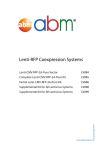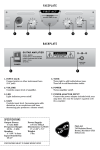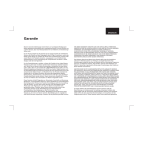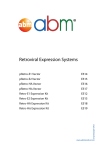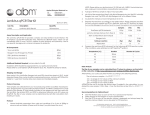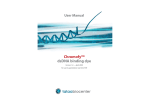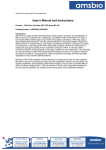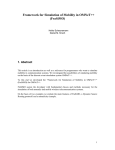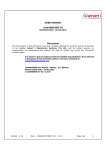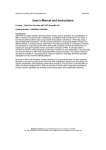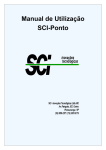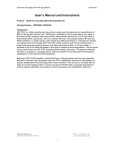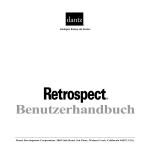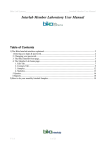Download User Manual/Hand book - Applied Biological Materials
Transcript
User Manual/Hand book qPCR miRNA Arrays ABM catalog # MA003 (human) and MA004 (mouse) Kit Components Cat. No. MA003...........................Human Whole Genome miRNA qPCR Profiling Kit (-20°C) The following components are sufficient for 3 reactions/samples. 384-well plate# H-1 3 plates 384-well plate# H-2 3 plates 384-well plate# H-3 3 plates qPCR plate adhesive films 9 pieces Including free: 2X EvaGreen miRNA qPCR Mastermix 5 ml* Cat. No. MA004............................Mouse Whole Genome miRNA qPCR Profiling Kit (-20°C) The following components are sufficient for 3 reactions/samples. 384-well plate# M-1 3 plates 384-well plate# M-2 3 plates qPCR plate adhesive films 6 pieces Including free: 2X EvaGreen miRNA qPCR Mastermix 5 ml* *Sufficient for two 384-well plates. Supplementary mastermix can be ordered for additional reactions (please refer to page 8 for contact information). Storage Conditions Store at -20°C in a frost-free freezer miRNA Profiling Handbook Page 1 of 8 Introduction MicroRNA (miRNA) are highly conserved, small non-coding RNAs that were first discovered in C. elegans in the early 1990’s. miRNAs are on average ~21-24 nt long and are processed from lengthier sequences called pri- and pre-miRNA (primary and premature miRNA, respectively). Mature miRNAs interact with RNA-Induced Silencing Complex (RISC) to repress gene expression through translation interference or mRNA degradation by binding to the 3’ or 5’ UTR, or open reading frame (ORF). Alternatively, some endogenous miRNA demonstrate potential positive gene regulation through transcriptional activation of related genes. This aspect of gene regulation provides complex mechanisms for more specific and controlled expression. A single miRNA may regulate multiple targets and each target mRNA may interact with multiple miRNAs. Researchers are presently investigating the functional role of miRNA in an extensive collection of cellular processes, including those associated with disease. Applied Biological Materials’ miRNA qPCR Profiling Kit is a thorough and sensitive tool innovatively designed for analyzing miRNA expression using real-time quantitative reverse transcription PCR, or qRT-PCR. The arrays simultaneously provide specific and relative comparison of mature miRNAs using high performance EvaGreen real-time PCR detection. In addition to four reliable endogenous controls, each 384-well array contains a collection of individually validated miRNA-specific primers designed for the detailed and high throughput analyses of mature miRNA sequences, as annotated by the Sanger miRBase Release 16, and are available for human and mouse study. Instrument-specific EvaGreen miRNA qPCR Mastermix is specially formulated to ensure the best specificity, sensitivity and reproducibility for miRNA expression analysis. To use the miRNA qPCR Array, reverse transcribe your experimental small RNA samples into first-strand cDNA. Then, mix the template with our high performance instrument specific EvaGreen miRNA qPCR Mastermix and aliquot the mixture into each well of the same miRNA-specific array. Perform qPCR and determine relative miRNA expression, normalized by the provided endogenous controls, with your real-time instrument and ΔΔCT method. Our uncomplicated miRNA PCR array is user-friendly for routine use in all research laboratories. Page 2 of 8 miRNA Profiling Handbook miRNA Profiling Process RNA Isolation -- isolate RNA from the sample cells or tissue using Trizol reagent. cDNA Synthesis -- use miRNA cDNA synthesis kit (G269 or G270, ABM) to synthesize cDNA Real-time PCR Reaction Setup -- mix the cDNA template with high performance 2X EvaGreen miRNA qPCR mastermix and aliquot the mixture into each well. Sample Analysis -- analyze sample using the specified qPCR machine and obtain the CT values for all miRNAs. Results Analysis -- analyze the results you obtained using the provided Excel sheet software. miRNA Profiling Handbook Page 3 of 8 Basic Protocol for miRNA Profiling 1. cDNA synthesis 1.1. PolyA tailing Reaction (Cat.No.: AM1350 , Ambion) In a thin-well PCR tube combine: Components Volume Total RNA Variable (~2 ug total RNA or 200 ng small RNA) 5X PolyA buffer 2 μl 25 mM MnCl2 1 μl 5 mM ATP 1.5 μl PolyA polymerase 0.5 μl RNase-free H2O Variable Final Volume 10 μl Incubate for 30 minutes, at 37°C. Store in -20°C. If not, proceed to cDNA synthesize immediately. 1.2. miRNA cDNA synthesis (Cat.No. G269 and G270, Applied Biological Material, Mandatory ) Attention: The qPCR miRNA arrays are only compatible with cDNA generated from ABM’s miRNA cDNA synthesis kits. The reverse primer, pre-loaded into each qPCR miRNA Array, specifically anneals to the proprietary miRNA Oligo (dT) adapter supplied in the miRNA EasyScriptTM cDNA Synthesis Kits (G269 & G270). Subsequently, any cDNA generated using other cDNA synthesis kits will not produce amplicon and/or yield any valid qPCR data. 1.2.1. Add 2 μl of miRNA Oligo (dT) adapter (10 uM) into the PolyA tailing products (in the tube from 1.1). 1.2.2. Incubate at 65°C for 5 minutes and let cool to room temperature for 2 minutes. 1.2.3. Add the following components into the tube from 1.2.2. Components Volume Concentration (Final 20μl) dNTP (10 mM) 1 μl 500 μM 5X RT Buffer 4 μl 1X RNasin (40 U/μl) 0.5 μl 20 U per reaction EasyScript 1 μl 200 U per reaction RNase-free H2O 1.5 μl - Final volume 20 μl - TM RTase (200 U/μl) Incubate the mixture at 42°C for 15 minutes. Immediately stop the reaction by heating at 70°C for 10 minutes. Chill on ice. Store in -20°C. If not, proceed to real-time qPCR immediately. Page 4 of 8 miRNA Profiling Handbook Basic Protocol for miRNA Profiling 2.Real-time qPCR Reaction Setup Note: Prepare a workspace free of DNA contamination. qPCR reactions should be assembled in a DNA-free environment. cDNA sample preparation, reaction mixture assemblage and the qPCR process, in addition to the subsequent reaction analysis, should be performed in separate areas. The use of “clean”, automatic pipettors designated for qPCR and aerosol resistant barrier tips are recommended. 2.1. Mastermix qPCR reaction set up for one 384-well qPCR plate 2.1.1.Mix the following components in a 15ml tube: Components Volume 2X EvaGreen miRNA qPCR Mastermix 5.0 ml First strand products from 1.2.3. (20 μl) 5 μl ddH2O 1.0 ml Total volume 6 ml Note: Kit only includes enough Mastermix for two 384-well qPCR plates. Supplementary EvaGreen miRNA qPCR Mastermix can be ordered for additional reactions (refer page 8 for contact information). 2.1.2. Thaw the 384-well plate at room temperature. Spin briefly to collect content at the bottom of well (There should be 4 μl of liquid preloaded in each well of the plate). Carefully remove the cover film on the 384-well plate before use. 2.1.3. Aliquot 6 μl of the mixture from 2.1.1 into every well in the provided 384-well qPCR plate. Cover the plate with the qPCR plate adhesive films provided in the kit. Centrifuge the plate to remove any bubbles in the wells. Examine the wells visually from underneath to make sure that samples have been added to all wells and that no bubbles are present. Bubbles remaining at the bottom of the well will interfere with the results. miRNA Profiling Handbook Page 5 of 8 Real-Time PCR Instrument Parameters 3. Instrument Setup Follow the manufacturer’s instructions as detailed for your specific real-time instrumentation. The following are parameters performed on the Roche LightCycler480 but can also apply to other 384-well system. 3.1. Leave your plate on ice while setting up the qPCR program detailed below. Duration Ramp Rate (°C/s) Cycle(s) 95°C 10 minutes 4.8 1 95°C 10 seconds 4.8 63°C 15 seconds 2.5 72°C 5 seconds 4.8 95°C 5 seconds 4.8 60°C 1 minute 2.5 40°C 30 seconds 2.5 Steps Temperature Pre-incubation Amplification Melting curve Cooling 40 1 1 Select Reporter dye as SYBR Green Fluorescence. 3.2. Calculate the threshold cycle (Ct) values for each well using the instrument’s software. 3.2.1 Select “Abs Quant/ Fit Points for All Samples” method under the Analysis tab. 3.2.2 Manually define the threshold value by viewing the amplification plots and adjusting the noise band above the background signal. For comparable experiments, it is recommended that the thresholds are the same across all the miRNA qPCR arrays. 3.3. Export the resulting threshold cycle values for all wells into an Excel spreadsheet form. 3.4. Analyze the miRNA qPCR data by using the miRNA qPCR Array Data Analysis Excel provided on the ABM website. Page 6 of 8 miRNA Profiling Handbook Data Analysis 4. Data Analysis in Microsoft Excel ABM provides a miRNA Array Data Analysis Excel file that requires the input of threshold cycle data from the real-time instrument. Once the cycle data has been entered for all the samples, the excel file will automatically present the results in a tabular format, a scatter plot and a colour array for easy comparison. 4.1. Access the miRNA Array Data Analysis Excel file through the ABM website (www. abmGood.com). 4.2. Input the Ct values of all the samples into the ‘Sample Data’ tab. If replicates are performed, enter the average Ct values instead. 4.3. The Excel File normalizes the miRNA expression levels for each sample using the 4 endogenous miRNA controls on each plate. 4.4. Under the same tab, view the fold difference and any up- or down- regulations between the test compared to the control sample. The results data can be sorted based on any of the categories in the excel file. 4.5. Visual representation of the fold differences can be seen on the ‘Plate 1’, ‘Plate 2’ and ‘Plate 3’ tabs. These pages are useful in identifying which miRNA samples have the biggest positive or negative changes. Yellow to Orange to Red to Dark Red/Brown symbolize increasing down-regulation while Green to Blue to Dark Blue to Black symbolize increasing up-regulation. The name of miRNA can be easily identified as the well numbers of this array correspond to the actual array locations. Everytime when new sample data is entered, remember to click refresh the 4.6. The fold difference data is also represented in the ‘Scattor Plot’ tab. The black line equals 1 and the pink lines equal positive and negative fold changes equivalent to the value indicated cell A8. This plot is most useful to determine good cut off ranges for the resulting data. miRNA Profiling Handbook Page 7 of 8 Contacts Applied Biological Materials Inc. Phone: Internet: (8:30am-4:30pm PST M-F) Toll Free: (866) 757-2414 Local: (604) 247-2416 Fax: (604) 247-2414 (24Hr.) Address: www.abmGood.com Email: Suite #8-13520 Crestwood Place Richmond, BC, Canada V6V 2G2 General Information: [email protected] Order Products: [email protected] Technical Support: [email protected] Business Development: [email protected] Distributors North America Canada/USA Applied BIological Materials Inc. Mexico Quimica Lavoisier S.A. de C.V. Tel: 52-333-848-8484 [email protected] Puerto Rico AVP Caribe Tel: 787-892-0047 Fax: 787-264-3816 [email protected] South Korea CMI Biotech Tel: 02-444-7101 Fax: 02-444-7201 [email protected] Taiwan Interlab Co. Ltd. Tel: +886-2-2736-7100 Fax: +886-2-2735-9807 [email protected] Japan Cosmo Bio Co. Ltd. Tel: 03-5632-9610/9620 Fax: 03-5632-9619 [email protected] India G-Biosciences, India Tel: 0120-4323330 Fax: 0120-4323299 [email protected] Israel BioConsult Tel: 972-(0)2-5667043 Fax: 972-(0)2-5662790 [email protected] Singapore Bio-REV PTE Tel: (65) 6273-3022 Fax: (65) 6273-3020 [email protected] United Kingdom NBS Biologicals Ltd. Tel: +44 (0)1480 433875 Fax: +44 (0)1480 459868 [email protected] Belgium Gentaur Tel: 32-2-732-5688 Fax: 32-2-732-4414 [email protected] France Gentaur Tel: 01-43-25-01-50 Fax: 01-43-25-01-60 [email protected] Germany BioCat GmbH Tel: +49 (0) 6221-7141516 Fax: +49 (0) 6221-7141529 [email protected] Italy Biosmart s.r.l. Tel: +39-0250994515 Fax: +39-0250994547 [email protected] Asia Europe Page 8 of 8 miRNA Profiling Handbook









